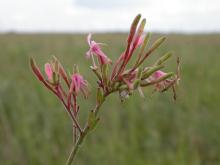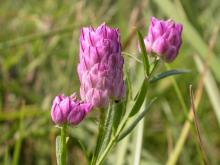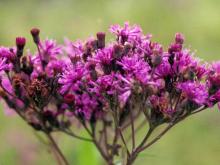Wildflowers, Grasses and Other Nonwoody Plants
Media
Species Types
Scientific Name
Vernonia baldwinii
Description
Ironweeds are tough, grayish-green, branching plants known for their fluffy-looking clusters of reddish-purple florets. They are a familiar sight on roadsides and pastures. Identify western ironweed by the bracts at the base of the flowerheads.
Media

Species Types
Scientific Name
Verbascum blattaria
Description
Moth mullein is a native of Eurasia introduced to our continent in the early 1800s. Since then, it has spread across North America. It’s named because the fuzzy flower, with 2 antennalike stamens, looks something like a moth.
Media

Species Types
Scientific Name
Carduus nutans
Description
An invasive native of Eurasia that is spreading in Missouri, musk thistle is a plant you should know. Learn how to tell the difference between our native thistles and these bad guys.
Media

Species Types
Scientific Name
Cirsium altissimum
Description
Tall thistle is a native thistle that can grow to be 10 feet tall! To identify it, notice its leaves, which are unlobed (though they may be wavy or have only shallow, broad lobes), are felty-hairy beneath, and have prickles only along the edges.
Media

Species Types
Scientific Name
Blephilia ciliata
Description
Square, unbranching stems, opposite leaves, two-lipped flowers, and a mild minty fragrance are clues Ohio horsemint is in the mint family. Tight, rounded flower clusters are stacked atop one another at the stem tips.
Media

Species Types
Scientific Name
Oenothera filiformis (formerly Gaura longiflora, G. biennis)
Description
Large-flowered gaura is a tall plant whose white flowers turn pinkish as they age. Four petals point upward, then bend back, and 8 stamens droop downward. The flowers look something like small butterflies.
Media
Species Types
Scientific Name
Erigeron philadelphicus
Description
The antique belief that this plant might repel fleas gives the fleabanes their name. There are more than 170 fleabanes in the genus Erigeron in North America. This one is scattered to common nearly throughout Missouri. Native Americans used this species medicinally for a variety of ailments.
Media

Species Types
Scientific Name
Polygala sanguinea
Description
The dense, cylindrical flower clusters of field milkwort are pink to white and, at first glance, look something like a clover head. This small annual wildflower is common in prairies, old fields, meadows, and glades.
Media

Species Types
Scientific Name
Symphyotrichum spp. (formerly Aster spp.)
Description
Missouri has 24 species of New World asters in genus Symphyotrichum. Most have purple or white ray flowers and yellow disk flowers that turn reddish over time. Most bloom in late summer and fall.
Media

Species Types
Scientific Name
Vernonia spp.
Description
Five species of ironweeds live in Missouri. Starting in the middle of summer, they bear showy clusters of magenta or purple flowerheads at the branching tops of upright stalks.
See Also
About Wildflowers, Grasses and Other Nonwoody Plants in Missouri
A very simple way of thinking about the green world is to divide the vascular plants into two groups: woody and nonwoody (or herbaceous). But this is an artificial division; many plant families include some species that are woody and some that are not. The diversity of nonwoody vascular plants is staggering! Think of all the ferns, grasses, sedges, lilies, peas, sunflowers, nightshades, milkweeds, mustards, mints, and mallows — weeds and wildflowers — and many more!





















